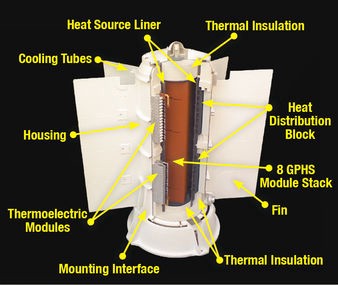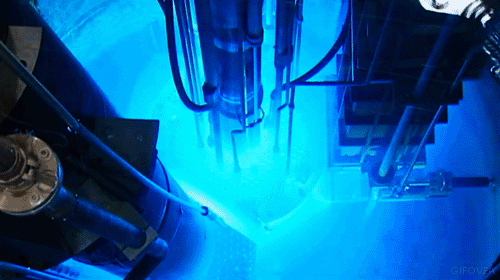The nuclear reactors powering some of the coolest tech from the world of science-fiction.
Written by David Watson
June 21, 2019

Space rockets, powerful weapons, deflector shields, replicators, travelling through space and time… if all this cool sci-fi tech really did exist (let me dream, will you?), have you ever thought about how they would require huge amounts of energy?
Although the genre is called science-fiction, sci-fi writers try to make their imagined inventions feel as real possible. This means imagining plausibly-huge power sources to fuel their energy-hungry technology.
Although the media keep telling us nuclear is a twentieth-century tech on the way out, sci-fi writers have always envisioned their space ships and time machines being powered by awesome, advanced nuclear reactors.

Let’s take a look at some of the nuclear reactors that have made it into sci-fi Hollywood and TV.
7. The Martian “RTG”
The iconic sci-fi novel The Martian was made into a hit movie starring Matt Damon in 2015. As Damon’s character Mark Watney battles to reach an old spacecraft many miles from his damaged base, he relies on a Radioisotope Thermal Generator (RTG) as a heat source for his Mars rover vehicle.
The RTG in the ‘The Martian’ is not a speculative future technology — we use them in our space missions today! RTGs use the decay heat from Plutonium-238 to make electricity. Not all the heat can be used; some is radiated to the surrounding air, which is why Mark Watney was so keen to spoon one of these bad boys through the cold Martian nights…
RTGs, also known as ‘nuclear batteries’ are the power source behind many long-term space missions, especially those heading into the outer solar system where sunlight is weak or where long mission times are hoped for. The most powerful nuclear battery we’ve deployed so far is onboard the Mars Curiosity rover; a 1-tonne science lab-on-wheels that has been working non-stop since August 2012.


6. Total Recall: Martian Reactor
Staying with the Mars theme, in the 1990 movie ‘Total Recall’, larger-than-life action hero Arnold Schwarzenegger manages to save the day (and himself) by restoring the Martian atmosphere, thus freeing the planet’s inhabitants from the corrupt governor Cohaagen’s crushingly-high oxygen prices. How does Arnie do this?
Although not part of the original Phillip K Dick book, in ‘Total Recall’ Mars is supposed to have been previously inhabited by an alien species who used an underground nuclear reactor to try to terraform the planet. The reactor was capable of generating oxygen (and presumably nitrogen too) stored deep inside the planet. Arnie manages to get the reactor going at the end of the movie, creating a fresh new atmosphere for the people of Mars.
…but there’s a good chance it was all just a dream…

5. Terminator: Iridium nuclear energy cell
Arnold Schwarzenegger seems to have a thing for nuclear technology. The T-800 series of terminator robots were like Engergizer bunnies; they just kept going and going and going and going…where did they get this relentless energy from?

It turns out that each terminator is equipped with an irridium nuclear energy cell with enough capacity to run at full power 24/7 for three years.
That explains why Sarah Connor had so much trouble getting away from this one-track-mind robot with attachment issues.
4. Iron Man: Arc Reactor
We’ve all seen the kind of stunts billionaire genius Tony Stark pulls off as Iron Man in the never-ending Avengers movie franchise: rockets for flight, weapons, shields, telecoms, you name it. The power feeding this capability comes from the Arc Reactor invented by Tony’s father, Howard. The Arc reactor uses nuclear fusion to provide almost limitless clean energy.
.png)
Numerous iterations of the Arc Reactor appear throughout the franchise, starting with a mini reactor inside Tony Stark’s chest that keeps him alive despite a shrapnel wound, and culminating in a version based on the Tesseract: a strange object of infinite power that can be used for good or evil.
Amazingly, MIT is currently developing a real-world Arc reactor using the latest high-temperature superconductor materials.
3. Back To The Future: Flux Capacitors and their power sources
Travelling through time in Back To The Future— be that with a flying Delorian or a pimped-out steam train — would not be possible without the brilliance of “Doc” Emmet Brown and his flux capacitor.

The only problem was that the flux capacitor consumed an enormous amount of power, 1.21 GW to be precise.
Without enough power, a time-traveller could become trapped in the wrong time period, something which almost happens to Marty in the first movie.
1.21 gigawatts is about the power produced by a typical large, light-water nuclear reactor operating today around the world. In the movie, Doc originally supplies this energy using a plutonium-fuelled nuclear fission reactor. Very good of him to recycle nuclear waste like next-generation nuclear reactors such as Moltex!

In later movies, he upgrades from plutonium to a nuclear fusion reactor that harvests hydrogen atoms from garbage (a single banana skin will suffice). I might suggest this next time my local authority reviews its recycling provisions.
2. Star Wars: hypermatter reactors
A list of sci-fi nuclear reactors would not be complete without mentioning Star Wars. Key to interstellar travel in George Lucas’s universe are reactors powered by exotic “hypermatter” annihilation, which accelerates “tachyons” to infinite velocities and allows for the jump to lightspeed. The hypermatter annihilation cores are in turn confined by nuclear fusion systems.

Not only does nuclear tech move the Millenium Falcon from zero to gone before you can shout “Wookie!”, they also meet the energy needs of whole planets: speeders, blasters, light sabers and all!

1. Star Trek: a nuclear-powered utopia
In Star Trek: the Next Generation, if Captain Jean-Luc Picard wanted to cruise along at relaxing sub-light speeds, he’d turn on the USS Enterprise’s nuclear fusion-powered “impulse drives”. If he was really in a hurry he’d switch on the “warp drive” and achieve faster-than-light travel by warping the space-time continuum around the ship.

The phenomenal amount of energy required to bend space and time is provided by a matter-antimatter reactor regulated by a mysterious crystal called “dilithium”. The reactor creates a magnetic plasma which interacts with the warp coils to create a space-time “bubble” that encloses the vessel.
When using warp drives, the Enterprise doesn’t so much as travel through space, but rather it stretches and compresses the space in front and behind to pull its destination towards it…or something. The amazing thing is that such a form of travel might just be possible under Einstein’s General Theory of Relativity.

In the Star Trek universe, a mastery of the various forms of atomic power by the Federation (like a beefed-up United Nations for the Galaxy) allowed humakind to enter a “post-scarcity” economy. Almost limitless energy meant materials could be created in “replicators” instead of mined and harvested from the surface of planets at great environmental cost.
This optimistic vision of the future is a refreshing break from the disaster porn sci-fi we’ve been subjected to in recent years.

Final Thoughts
Fission, fusion, antimatter or even (as yet) fictional hypermatter share something in common: they all make use of the energy tied up inside the nucleus of an atom or, in the case of antimatter, the energy of mass itself, to provide huge amounts of energy from a reactor small enough to fit inside a spaceship, vehicle or suit. It’s this energy density that makes nuclear the obvious choice for sci-fi technology.
Bonus: Foundation “atomics”
All those cool sci-fi reactors, and not a mention of Isaac Asimov’s Foundation series, where the main premise is that without atomic energy there is no advanced civilisation? The books raises so many interesting questions it deserves its only article — coming soon! Follow the Generation Atomic publication and make sure you don’t miss it.



